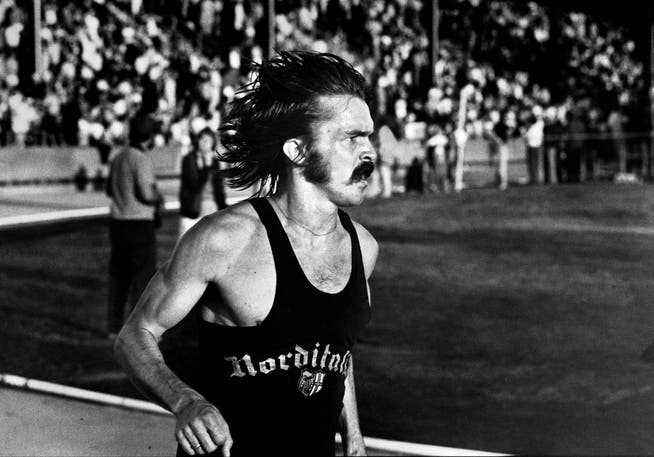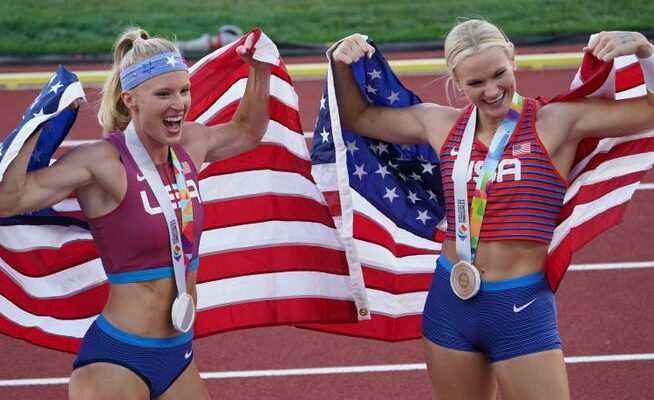The world association handed the World Cup over to Eugene, where it will now be held in a small stadium. The aim is to push a sport that is only number 9 in the eyes of the American public.
The hostesses flex their muscles: Katie Nageotte (right) wins gold in the pole vault, Sandi Morris silver.
US athletics are showing their full potency in Eugene these days. On Saturday, all three medals in the men’s sprint over 100 m went to the hosts of this World Championships. And on Sunday, the athletes celebrated the most successful day in the history of athletics under the Stars and Stripes: They won nine medals, four of them in gold – never before has a nation been so successful on a single day.
This snapshot fits into the big picture. At the previous World Championships, US athletes collected a total of 381 medals, more than twice as many as the second-placed Kenyans (150). The USA would even be at the top of this ranking if you only counted their 170 gold medals. And yet Eugene’s title fights in the 39-year history of the World Cup are the first to be held in the USA.
The President was once on the payroll at Nike
It took a few tricks and tricks. The driving force behind the candidacy for the World Cup was the sporting goods giant Nike, which was founded in Eugene. When the Oregon location was awarded the contract in the spring of 2015, Sebastian Coe was a Nike ambassador and was paid £100,000 per year, which at the time was just under CHF 150,000. Coe, who would become president of the world association a few months later, was on the board when the latter smuggled the occasion to Eugene. That was in the interest of the sport, was the reasoning.
Coe still stands by that today. In the run-up to the World Cup, he repeatedly emphasized how important it was to make athletics more popular with the American public. Because this sport, like many others, is only of interest here when the Olympic Games are being held. The world association commissioned a study in 2019, the result of which was sobering: athletics ranked ninth in terms of public interest. The big team sports lead the way, but even swimming attracts more crowds than athletics.
Coe sees a great opportunity in working with the US association to increase awareness over the next six years. The 2028 Olympic Games will be held in Los Angeles. According to the “Los Angeles Times”, there will be annual meetings with national and international stars in five cities from 2023. The aim is to build up a fan base so that athletics becomes more attractive for the TV stations.
The 2022 World Cup is also a starting point for this. After all, NBC is broadcasting live for twelve hours and has set up a live window in prime time for the first time in World Cup history. Is that enough to start a fire? After the title fights, the entourage will fly back to Europe, where it will continue until the final of the Diamond League on August 7th and 8th. September stays in Zurich. 9 out of 13 meetings in this series take place on the old continent. In the USA, live images are only available on a payment channel on the Internet.
Athletics is alive only in Eugene
Eugene also conducts an annual Diamond League meeting. There are people who claim it is the only US city where professional athletics is still alive. Since 2008, the US Olympic Trials have been held here and 8 of the last 14 national championships have been held here.
It is no coincidence that Nike was founded here. Phil Night was a member of the successful track and field team at the University of Oregon and Bill Bowerman was his coach. The two started a company in 1964 that imported running shoes from Japan and sold them to students. From 1971 they produced their own shoes. Today, Nike is the world’s largest sporting goods company with a Sales of over $40 billion.
Professional US athletics would be unthinkable without the Oregon company. It is the largest sponsor of the national federation USATF, which it supports annually with 20 million dollars. She has outfitted countless US athletes with kit deals, enabling them to live professionally. The World Cup would never have come to Eugene without Nike, although ironically Asics is now omnipresent in the stadium as the official partner of World Athletics. Not a single top sponsor of World Athletics comes from the USA.
The stadium in Eugene was converted for the title fights, the $270 million for which came from private individuals, mostly from Nike co-founder Night and his wife. And Hayward Field says something about the importance of athletics in America. The world association actually requires stadiums with 40,000 seats for the World Cup. But that would have been hopelessly oversized in Eugene.
For this reason, the capacity was only increased from around 8,500 to 15,000 during the renovation. The regional newspaper “The Oregonian” finds that too big. The arena has never been sold out, but it is well filled with an audience that understands something about athletics. This is a pleasant contrast to previous World Cups with many empty seats in large cauldrons.
The audience’s expertise is no accident. Eugene calls himself Track Town USA, athletics has a rich tradition here, mainly because of university sports. Hayward Field is on the university campus, and there are several running tracks along the Willamette River that are busy every day.
One of these tracks is named after Steve Prefontaine, athletics’ first rock star. He began his career as a runner at the University of Oregon, his coach was Bill Bowerman. He brought him to Nike in 1974, where the athlete signed a $5,000 contract. It was Prefontaine that made the brand famous. But just a year after the big deal at the time, he drove his golden convertible into a rock and died. He was 24 years old then. Nike had a statue erected for the runner, the site of the accident was named Pre’s Rock and is still a place of pilgrimage for runners today.

With a mustache and Nike shoes: Steve Prefontaine in his last race. The following night he drove his gold convertible into a rock and died.
Like Prefontaine in the past, US talent today almost exclusively comes from student sports. At high schools they get an excellent basis, at universities they often train under professional conditions. There are around 1,000 college teams for women and men, and tens of thousands of athletes compete almost every week from March to June in competitions organized by the NCAA student sports organization.
The level at the top is very high, the records in the 100m for example are 10.75 for women and 9.82 for men. The strict amateur principle applies. Once a student signs a contract with a shoe company, they are no longer eligible to compete in the NCAA.
These contracts are vital for young athletes. Paul Doyle, one of the top athlete managers in the US, says the situation has changed drastically in recent years. Superstars in the big sports are getting bigger and bigger contracts, and even the very best track and field athletes are still being hired. But in the past, 25 to 30 college graduates with good prospects would have gotten kit deals that guaranteed them high five-figure or even low six-figure sums in dollars annually.
“That money isn’t there anymore,” Doyle told the Oregonian. In addition, the entry and prize money at the international meetings has shrunk by a third. With these perspectives, it is becoming increasingly difficult for US athletes to bet on a sport that hardly anyone is interested in at home.
The Philadelphia Eagles liked what they saw from Devon Allen at the Pro Day and signed him to a contract for the 2022 season. https://t.co/K5NVxk8DcQ
— Ducks Wire (@Ducks_Wire) April 8, 2022
It’s tempting to do like Devon Allen, who ran the best time of the year in the 110m hurdles at 12.84. He had previously signed a three-year contract in American football worth $2.5 million. Allen said at the time that he would still contest the World Cup in the stadium of his former university and then move to the training camp. However, the title fights didn’t bring him any luck – he was disqualified in the final for a false start.
